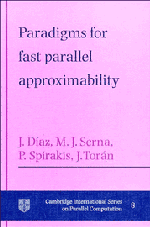Book contents
- Frontmatter
- Contents
- Preface
- 1 Introduction
- 2 Basic Concepts
- 3 Extremal Graph Properties
- 4 Rounding, Interval Partitioning and Separation
- 5 Primal-Dual Method
- 6 Graph Decomposition
- 7 Further Parallel Approximations
- 8 Non-Approximability
- 9 Syntactically Defined Classes
- Appendix 1 Definition of Problems
- Bibliography
- Author index
- Subject index
9 - Syntactically Defined Classes
Published online by Cambridge University Press: 19 March 2010
- Frontmatter
- Contents
- Preface
- 1 Introduction
- 2 Basic Concepts
- 3 Extremal Graph Properties
- 4 Rounding, Interval Partitioning and Separation
- 5 Primal-Dual Method
- 6 Graph Decomposition
- 7 Further Parallel Approximations
- 8 Non-Approximability
- 9 Syntactically Defined Classes
- Appendix 1 Definition of Problems
- Bibliography
- Author index
- Subject index
Summary
In Chapter 2, we presented several complexity classes based on the approximability degree of the problems they contain: APX, PTAS, FPTAS and their parallel counterparts NCX, NCAS, FNCAS. These classes, defined in terms of degree of approximability, are known as the “computationally defined” approximation classes. We have seen that in order to show that a problem belongs to one of these classes, one can present an approximation algorithm or a reduction to a problem with known approximability properties. In this chapter we show that in some cases the approximation properties of a problem can be obtained directly from its syntactical definition. These results are based on Fagin's characterization of the class NP in terms of existential second-order logic [Fag75], which constitutes one of the most interesting connections between logic and complexity. Papadimitriou and Yannakakis discovered that Fagin's characterization can be adapted to deal with optimization problems. They defined classes of approximation problems according to their syntactical characterization [PY91]. The importance of this approach comes from the fact that approximation properties of the optimization problems can be derived from their characterization in terms of logical quantifiers. Papadimitriou and Yannakakis defined the complexity classes MaxSNP and MaxNP which contain optimization versions of many important NP problems. They showed that many MaxSNP problems are in fact complete for the class. The paradigmatic MaxSNP-complete problem is Maximum 3SAT. Recall that the Maximum 3SAT problem consists in, given a boolean formula F written in conjunctive normal form with three literals in each clause, finding a truth assignment that satisfies the maximum number of clauses.
- Type
- Chapter
- Information
- Paradigms for Fast Parallel Approximability , pp. 128 - 136Publisher: Cambridge University PressPrint publication year: 1997

